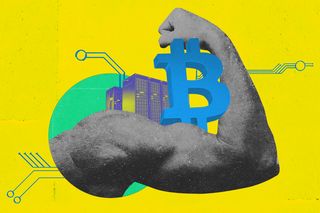
Blockchain Ideology Is Rooted in Exclusion. A Feminist Lens Shows Why
A masculinist approach to tech focuses on creating value out of the Internet “commons” through ownership — just like we did with land.

Depending on who you ask, blockchain applications can seem like many things at once. They’re simultaneously radical, decentralized, destructive, exclusionary, bro-y, and just plain difficult to understand.
The biggest draw of blockchain technology, like crypto and NFT, is the promise of more wealth and more ownership rights. Success stories of people “getting in” on some cryptocurrency or the other can be tantalizing: as economies fail, public welfare systems collapse, and there’s greater disillusionment in big government than ever, the theoretical prospect of making money without the state’s interference is positively utopian. We are told that blockchain applications create value and are valuable. But it’s worth examining what exactlyvalue isover here to determine who benefits.
With crypto and NFT, the meaning of value is abstracted to a degree that makes it hard to grasp and even harder to access. “I’ve never read so many words about anything and gotten so little out of it…There’s a level of deceit in the whole construction here of what is value,” says Zillah Eisenstein, feminist activist and professor Emeritus at Ithaca College, New York.
This abstraction works to obfuscate the fact that these storehouses of value are leading us into catastrophic ecological decline and devaluation of women’s bodies and labor. “It should not be surprising to anyone that, in the most historically unequal time, we have a technology emerging that I would say encourages excessive wealth. If you’re encouraging excessive wealth, you’re also encouraging excessive inequality,” points out Eisenstein.
It’s easy to wonder how, at face value, blockchain could be related to any of this. But the underlying instinct behind blockchain – creating and storing value for its own sake – is inherently exploitative.
Historically, this ideology can be traced all the way back to the 16th century, when feudal overlords began appropriating common lands as private property, eventually leading to the devaluation of women’s labor within the private sphere. Blockchain represents a similar logic of enclosing and owning what was once public: the digital space. And it bears little meaningful relationship to the labor that women and marginalized communities do in real life.
“There’s no actual materiality to it; value is being created. And that value is being created by creating artificial enclosures in digital spaces, and then trying to monetize those enclosures,” says Urvashi Aneja founder of Digital Futures Lab.
Related on The Swaddle:
What Will Protect People From Hate Crimes in the Metaverse?
The value embodied by blockchain applications has no use for anyone who performs labor for value that can be exchanged for the commodities required to live. Women, marginalized castes, races, and minorities whose work is devalued or undervalued can rarely, if ever, see their labor valuated in the form of crypto or NFTs, because the idea of value embodied here has nothing to do with their lived realities. Instead, the inherent draw is simply in creating value out of ownership and then exchanging it for large sums of money. In the blockchain, it isn’t possible to represent the work that people do; it is simply meant to represent ownership of some kind of value. Who, then, is benefiting?
Despite blockchain’s promise of overcoming authority and centralization, feminist histories show how the very premise of this tech is rooted in exclusion and hypermasculinity. Women’s bodies have always embodied the tenuous relationship between labor and value. That blockchain represents an opportunity to create value without labor makes it an inherently masculinist preserve. Experts note that it’s based on the libertarian ideal of greater individual freedom under least regulation, government interference. But has few applications in ways that really matter, and only a few seem to be able to reap the rewards promised under this ideology.
“I can’t imagine crypto working for a domestic worker in Indonesia… If we ask ourselves what most women workers are doing, how would crypto help them? What about the labor that there is no exchange for?” asks Eisenstein.
In other words, digital space is now itself a resource to be mined for profit and ownership for their own sake. We might soon speak of “digital resources” the same way we speak of “natural resources,” where music, art, space in general, and virtually every aspect of digital existence can be mined for profit. “NFTs don’t have to possess some inherent value, as long as they’re worth the hype, which not only devalues art but also makes things really hard for people not participating within the marketplace,” says Jishnu, a digital artist.
The only thing that blockchain seems to achieve, at the moment, is giving people – usually men with the technical knowhow and the money – a place to store wealth. Not only that, digital tokens allow for the creation of new places to store value – coins and the Bored Ape Yacht Club, to speak of a few. Writer Tressie McMillan Cottom describes it as a set of “parking lots” to “park” value. The problem with this is the same as the problem with housing: by itself, essential and life-saving. But driving up the market value of housing, creating more land to own and storing more wealth is not only not essential but also now defines who gets to live, die, starve, and prosper.
Thus, blockchain, like real estate, ultimately becomes a way to store power, not value.
***
Blockchain is the backbone of what some have called “Web3.” It is a rhetorical step forward from Web2: a user-driven space that is participatory and easy for anyone to use. The elevator pitch is that this is a good thing, because Web2 is currently owned by the tech overlords Meta, Amazon, Google – all companies that hamper user independence online.
This is ostensibly true, except for one catch: The same people who funded the big bad corporations that currently control Web2 are pouring billions into blockchain too. Venture capitalists are also, overwhelmingly, making big bucks off blockchain technology. And the very same companies that have fuelled distrust in big tech and government are now rebranding themselves using blockchain technology – driving up their own valuation and lining the pockets of venture capitalists in the process.
“Blokechainers”, as some feminists have christened them, would have us believe that tokenizing the Internet is the way forward. Someone is always reaping mighty rewards from blockchain, which must mean that anyone can. But this egalitarian pipe dream falls apart at the fact that the backbone of blockchain technology is staggeringly large sums of money being casually swapped among big players in the space.
“[Crypto] is not a currency, it’s actually a kind of speculative asset… that is allowing people to make a lot of money, but it’s not necessarily something that is enabling individual freedoms or helping address corruption or enable kind of trust,” says Aneja.
Related on The Swaddle:
How Crypto ‘Bro’ Culture Around Finance Is the New Toxic Masculinity
The result is a hyper-masculine ethos guiding an already masculine logic of tech: the idea that the commons – in this case, the digital commons – exist to simply own and store wealth without any labor. To put this abstraction into perspective, take this phenomenon that is currently unfolding: the minting of colors as NFTs. Under the blockchain regime, it is now possible to stake one’s ownership of a specific shade of white, for instance – thereby forcing anyone who uses that color to pay the owner. It is like paying rent to make art. It is, in other words, a new kind of property regime. We have already enclosed land, water, and soil; now, we have begun enclosing the virtual space that used to be free.
It is the same way land began to be viewed as “belonging” to someone (a man) – there is no practical reason that should have ever happened. Similarly, there is no practical reason for bitcoin, blockchain, or NFT to exist. It propels individualism to a degree that makes us lose sight of what value really means, allowing several already rich individuals to get richer, faster. But the knowledge remains concentrated in the hands of a few mostly white men. The rules of this supposedly decentralized space are made up by a few; the “consensus” they pride themselves on is the consensus of a few.
“The opinions held by certain very powerful people still determine the future of crypto,” says Shreya Mukta, a researcher at the intersection of tech, gender, and design, referencing the influence of Elon Musk’s opinions on the value of crypto.
Equally masculine is “this idea that we can establish trust through technological architectures, as opposed to social relationships… power in the hands of individuals completely glosses over the structural conditions of inequality, the structural conditions that lead to oppression, the structural conditions that limit people’s opportunities,” Aneja adds.
***
Is there real revolutionary potential hidden underneath all the baggage? One prominent example seems to suggest so. Feminist punk band Pussy Riot recently raised millions of dollars in funds to assist Ukraine through the sale of the Ukrainian flag as an NFT. The idea behind it being that institutions monitoring fiat currency cannot be trusted. “Revolution could not be achieved with conventional currencies, there are too many ways for traditional funds to be intercepted by traditional institutions, governments, other factions with intent to control, harm, simply shift funds without transparency,” Pussy Riot said in a tweet.
On the flipside, there is also the fact that the value of Bitcoin has soared since the Ukrainian crisis – making a devastating war a profitable enterprise for a few individuals.
“As with anything tech, it’s a function of the socio economic factors that apply to it as opposed to a function of the tech itself,” Aman Nair, from the Center for Internet and Society, adds.
If we’re not careful, we can end up doing to digital space what we have done to ourselves in the real, tangible world. We may end up in a place where it is difficult to exist on the Internet without buying Internet real estate. Taking blockchain seriously opens up a risk of digital “starvation” for those who cannot afford it, those who are already left out by conventional structures. We may even die digital deaths if the Internet simply becomes too expensive, secluded, and hyper-optimized to live in.
And so to critique blockchain isn’t to decry that it is dominated by men but to critique domination itself. It isn’t to ask for inclusion of this or that interest group, it is to turn the idea of inclusion itself on its head.
As scholar Donna Haraway points out, there is no neutrality in any tech. The algorithm is “situated knowledge” – it is what people make of it, defined and governed by the rules that people build into it. It is contextual. And the people, inescapably, are overwhelmingly cis, white men in Silicon Valley. A look at fears over the crypto bubble “bursting” – just last month, a massive scam defrauded people of millions in Bitcoin – shows that code, just like humans, is not infallible because it is ultimately made by humans.
The big question is: what would happen if we were to resist it? Lessons from history show an ugly end to those — particularly women — who did resist a similar logic of capture and ownership; a violence that further cemented the power of property in society. Haraway’s essay, A Cyborg Manifesto,provides clues to what cybernetics should look like – technology that breaks down barriers rather than cements them further. For instance, blockchain technology reinforces the barrier between nature and culture by valorizing the rewards of crypto over the massive environmental costs — even shifting from a “proof of work” to a “proof of stake” model prompts questions about the fundamental ideology at play. It reinforces the divide between masculine and feminine when it is articulated and defined by men in the global north. It is intensely private, overtly masculine, and premised on exploiting not only the digital space but the physical environment too. For as much as we like to believe otherwise, the virtual is material, and blockchain in particular is frying the planet like no other technology so far has.
The key is not to shy away from tech, but to direct it towards more openness, more dissolution of boundaries, more community and collectivity. Blockchain, crypto, and NFT currently achieve the very opposite of these things. They are not for anyone except those who understand them and can profit from them. They speak of decentralization, never explaining what, exactly, is decentralized – the power to plunder.
A fairer, more just use of the Internet isn’t more privatization, no matter what riches are promised. It’s to reject value that is made up and drive it towards what is already here and valuable: life, equality, and nature. There are very few use cases for blockchain that promise betterment for any of these. Turning off the power-grids that hold the planet in a death grip for the sake of ephemeral rewards, therefore, may lead us back to where we want to be.
Rohitha Naraharisetty is a Senior Associate Editor at The Swaddle. She writes about the intersection of gender, caste, social movements, and pop culture. She can be found on Instagram at @rohitha_97 or on Twitter at @romimacaronii.
Related


Prehistoric Humans May Have Used Firelight to ‘Animate’ Art
